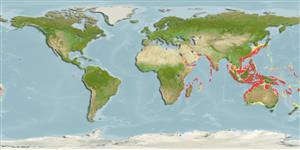Actinopterígios (peces con aletas radiadas) >
Scorpaeniformes (Scorpionfishes and flatheads) >
Triglidae (Searobins) > Triglinae
Etymology: Lepidotrigla: Greek, lepis, lepidos = scale + Greek, trigla, es = red mullet (Ref. 45335). More on author: Günther.
Medioambiente / Clima / Gama
Ecología
; marino demersal; rango de profundidad 54 - 256 m (Ref. 3542). Tropical, preferred ?
Indo-West Pacific: museum specimens from the Red Sea, Somalia coast and Zanzibar. Also known from the Bay of Bengal, Arafura Sea and the Philippines. Reports from Japan are based on a different species.
Tamaño / Peso / Age
Maturity: Lm ? range ? - ? cm
Max length : 10.0 cm TL macho / no sexado; (Ref. 30573)
A tropical to warm temperate species (Ref. 9771). Occurs over soft bottom of the continental shelf. Benthic (Ref. 75154). Excellent food fish (Ref. 3542).
Life cycle and mating behavior
Madurez | Reproducción | Puesta | Huevos | Fecundidad | Larva
Richards, W.J., 1984. Triglidae. In W. Fischer and G. Bianchi (eds.) FAO species identification sheets for fishery purposes. Western Indian Ocean (Fishing Area 51). Vol. 5. FAO, Rome. pag. var. (Ref. 3542)
IUCN Red List Status (Ref. 115185)
CITES (Ref. 94142)
Not Evaluated
Threat to humans
Harmless
Human uses
Pesquerías: escaso valor comercial
Más información
ReferenciasAcuiculturaPerfil de acuiculturaRazasGenéticaFrecuencias de alelosheritabilidadEnfermedadesProcesamientoMass conversion
ColaboradoresImágenesStamps, CoinsSonidosCiguateraVelocidadTipo de nataciónSuperficie branquialOtolitosCerebrosVisión
Herramientas
Special reports
Download XML
Fuentes de Internet
Estimates of some properties based on models
Phylogenetic diversity index (Ref.
82805): PD
50 = 0.5000 [Uniqueness, from 0.5 = low to 2.0 = high].
Bayesian length-weight: a=0.00724 (0.00320 - 0.01640), b=3.07 (2.88 - 3.26), in cm Total Length, based on LWR estimates for this (Sub)family-body shape (Ref.
93245).
Nivel trófico (Ref.
69278): 3.3 ±0.3 se; Based on size and trophs of closest relatives
Resiliencia (Ref.
69278): Alto, población duplicada en un tiempo mínimo inferior a 15 meses (Preliminary K or Fecundity.).
Vulnerability (Ref.
59153): Low vulnerability (17 of 100) .
